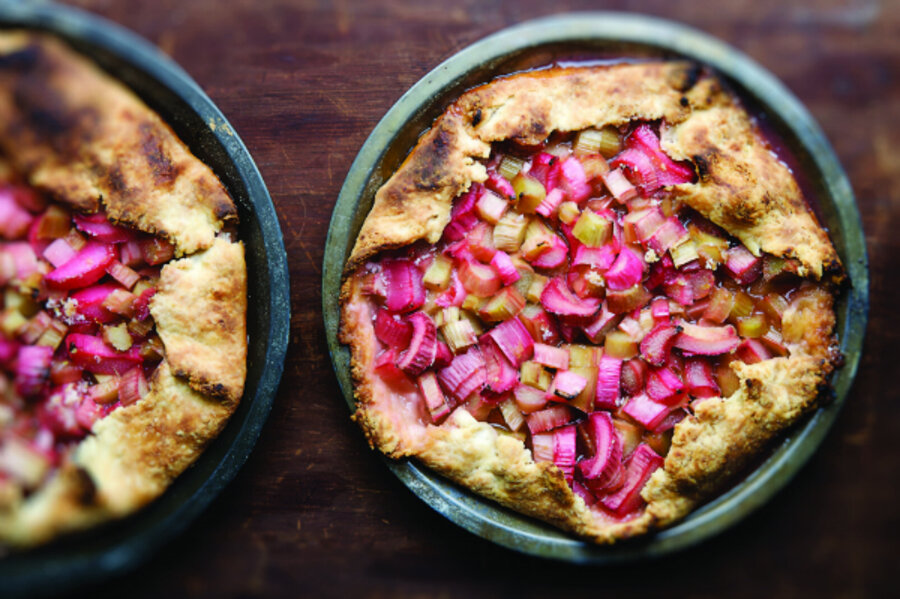Cookbook review: The Farm by Ian Knauer
Loading...
Imagine going out to the garden in the evening, still undecided about what to make for dinner. Wandering around the patches of fresh produce – zucchini, corn, cilantro, tomatoes, and lettuce – a few ingredients begin to form a meal.
Maybe it’s asparagus and green beans to go with roast chicken. Or perhaps cilantro and jalapeños to spice up chicken wings. Don’t forget strawberries for dessert.
If you are like me, utterly unimaginative when it comes to combining ingredients (let alone how to grow them), a recent cookbook may help expand the spectrum of what is possible in the kitchen – all with ingredients fresh from the farm.
The Farm: Rustic Recipes for a Year of Incredible Food, by Ian Knauer (Houghton Mifflin Harcourt, April 2012, $30) introduces readers to the process of how our food ends up on our tables. The farm-to-table movement is a way of life for Mr. Knauer, who shows how an appreciation for the land can unlock a new world of flavors and ideas.
In the foreword, former Gourmet magazine editor in chief Ruth Reichl writes, “Ian’s cooking begins in the garden and the fields; he demands an intimate relationship with his ingredients.”
Knauer started out at Gourmet as a cross-tester – he acted like a potential reader and tested all the recipes before they were published. Eventually he worked his way into a food editor position where he concocted his own recipes in the magazine’s test kitchen. He often brought in produce he raised himself, or meat he killed while hunting (he shares a tale of his first hunting expedition in the book).
His expertise in the basics of fresh ingredients comes from doing chores on his grandfather’s farm during his childhood and teenage years – mowing the lawn, pulling weeds, picking strawberries, and collecting walnuts. An immigrant German patriarch founded the farm (and the village of Knauertown) in the late 1700s and passed it down through generations of the Knauer family. Knauer’s grandfather was the last to work the land, until decades later when Ian Knauer, his sisters, and cousins started to replant the untouched farm and reconnect with their childhood memories.
The recipes in “The Farm” follow the seasons, using ingredients in their prime for the best flavor. Beets and strawberries come earlier than corn or peaches. Patience is key with growing peppers because they only flourish in the peak heat of summer. As the summer months begin to cool, butternut squash and chard are in abundance.
Beyond recipes, Knauer provides cooking tips from his years of experience. The best way to cook a hard-boiled egg, for instance, is to bring the water to a gentle boil and let it simmer. Hard-boiling has nothing to do with it. He explains how to differentiate between poisonous and nonpoisonous mushrooms when foraging on the farm: nonpoisonous chanterelles grow in groups of no more than two from the dirt, and they have fork-like veins instead of gills. Another handy skill is how to roast a pig. He advises digging a pit in case you don’t have a spit. (I have a friend who has annually hosts a pig roast in urban Washington, D.C., so this can be done even if you don’t live on a backcountry farm in Pennsylvania.)
There are recipes for every level of culinary knowledge. With my moderate experience, I decided to tackle Rhubarb-Sour Cream Crostata Pie. While I didn’t pick the ingredients I used fresh from the garden, I stood in the middle of the produce section of my local grocery store and tried to imagine the farm – its smells, the summer heat, and the grimy sweat from a long day of weeding and plucking.
Back at home, I set to work mixing the dough ingredients. I made the mistake of leaving cracks in the dough ball when I put in the refrigerator to cool. When rolling out the dough, those cracks made it difficult to make the crust completely round. Next came chopping the rhubarb. Rhubarb is best when it's deep red. Mine was a mixture of red and a little bit of green. As I chopped the one-inch pieces, I was worried that I might accidentally be using celery; the stalks look so similar when rhubarb is green.
I waited until the crostata cooled to room temperature before tasting it. The cornmeal crust was the perfect nutty texture for the syrupy and tart filling. Originally skeptical of the sour cream, it was just enough cream to complement the rhubarb.
It’s definitely a dessert I will make again, and maybe then I will make the journey to find fresh rhubarb from a local farm.
(The following is excerpted from "The Farm," © 2012 by Ian Knauer. Reproduced by permission of Houghton Mifflin Harcourt. All rights reserved.)
Rhubarb-Sour Cream Crostata Pie
A little bit of cornmeal in the crust adds a nutty note to this rustic spring pie. Rhubarb is a favorite of my cousin, Leif, who, when he met this pie for the first time at the farm, ate it in slices – wide-eyed and smiling – right from the pie tin, as if it were a dessert pizza.
For the pastry dough:
1-1/4 cups all-purpose flour
1/4 cup finely ground cornmeal
1 teaspoon light brown sugar
1 stick unsalted butter, cut into cubes
1/2 teaspoon kosher salt
2-3 tablespoons cold water
For the filling:
1/4 cup sour cream
5 cups (1-inch pieces) sliced rhubarb (1 pound)
3/4 cup sugar
1 teaspoon finely grated lemon zest
Make the pastry dough: Work together the flour, cornmeal, brown sugar, butter, and salt with your hands until it is mostly combined, with some small lumps of butter remaining. Stir in 2 tablespoons of the water with a fork. Press a small handful of dough together: if it looks powdery and does not come together, stir in the remaining 1 tablespoon water. Transfer the dough to a sheet of plastic wrap. Using the edge of the plastic, fold the dough over on itself, pressing until it comes together. Form the dough into a disk, wrap completely in the plastic, and chill for 1 hour.
Preheat the oven to 425 degrees F, with a rack in the middle.
On a well-floured surface, roll out the pastry dough with a floured rolling pin into a 12-inch round. Place the dough in a 10-inch pie tin.
Make the filling: Spread the sour cream evenly over the bottom of the crust. Toss the rhubarb with the sugar and lemon zest, then spread the fruit evenly over the sour cream. Fold the border of dough up and over the edge of the fruit.
Bake the crostata until the crust is golden, the filling is bubbling, and the rhubarb has started to brown, 45 to 50 minutes. Cool on a rack and serve warm or at room temperature.
Serves 6 to 8







